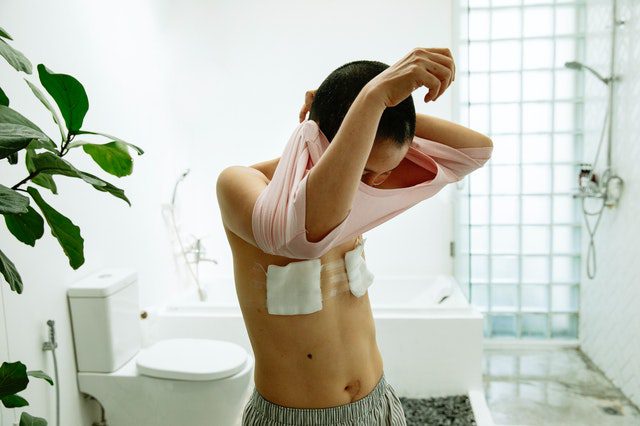
Top Surgery Recovery
When transmasculine patients have mastectomies done to remove all breast tissue and reconstruct the chest into a more masculine or neutral shape, it is referred to as a top surgery. Top surgeries, also referred to as FTM top surgery, fall under the category of gender affirming surgeries.
Different Top Surgeries
A double incision top surgery is used most often, especially in patients with larger chest size. Two long incisions are made horizontally on the chest. After this, the breast tissue is removed without harming the pectoral muscle. Sometimes the surgeon will perform additional liposuction to ensure a more natural male chest contour, and to prevent complications such as “dog ears”. This step is especially important for patients with a naturally curvier body type.
Nipple grafts can also be performed, wherein the nipples are removed, re-sized, and placed in a more natural position. Unfortunately, this can cause nerve damage and loss of nipple sensation. Some surgeons opt instead to simply reposition the areola as is, without grafting.
There are other ways to perform a top surgery procedure and preserve sensation in the nipple area, such as the keyhole top surgery. Surgeons will make a small incision, along the underside of the areola, and breast tissue removed that way.
For patients with a small chest, periareolar top surgery can be performed. During this surgery, one circular incision is made around the nipple, depending on the chest size, and the tissue is removed through it. The excess skin is then removed, and the remaining skin is pulled taut around the nipple.
Regardless of which type of top surgery is performed, it remains a major surgical procedure and will require a lengthy healing process- But there are some ways to improve or even speed up your recovery time.
Get Enough Rest
One of the most important steps in any major surgery recovery process, is to get enough rest. Top surgery, or female to male surgery, is no exception.
It is, therefore, important that you take time away from work and other strenuous activities until you have fully recovered from your chest surgery. Try to limit your mobility as much as possible.
In general, patients can begin a light physical activity and sedentary work/ a desk job in the first week after surgery, but any taxing physical activity should be avoided for no less than three weeks post-op. Avoid stretching or lifting your arms as much as you can.
If your top surgery included two horizontal lines across your chest, it’s best to completely avoid lifting your arms over your head for at least three months after surgery. This will not only aid in a quicker recovery time but also avoid excessive scarring.
Patients who are used to regular workouts, chest exercises, and heavy lifting should avoid these for at least 6 weeks after their top surgery.
Stick instead to light exercise, like walking, until you are fully healed. While avoiding any strenuous activities, it is highly recommended and very important to walk for a little bit each day. This will help prevent blood clots.
What To Expect
Bruising, Swelling, Discomfort
It is normal to experience a certain amount of discomfort, swelling and bruising after a chest reconstruction surgery. For a few weeks prior to your surgery, you will need to discontinue certain medications, not drink alcohol, and stop smoking. The same goes for your recovery period.
Your surgeon will provide you with a list of medications to avoid, and a list of suitable medications to manage pain during your healing process. Things such as anti-inflammatory drugs and blood-thinners are best avoided unless stated otherwise by qualified plastic surgeons.
Compression Vest
For comfort and support, the chest is wrapped in gauze and a compression binder or vest from one to six weeks after top surgery. This vest helps to reduce swelling, prevent fluid retention, and aids in skin tightening/ adhering back to the chest wall.
Drains
Most patients, but especially those who had larger breasts before surgery and, therefore, had more tissue to be removed, will need surgical drains, in each incision line, for some time after the operation.
These medical drains temporarily aid in getting rid of excess blood and fluid from the surgical area. They will need to be emptied each day, and how long they remain is determined by the surgeon- it could be anything from a few days to one week after surgery.
Drain removal will happen during a postoperative appointment.
Wound Care
Proper care of your wounds is very important to prevent infection, minimize scarring and bruises, and reduce swelling.
You will likely need to stay overnight at the hospital following your surgery, but many surgeons allow patients to return home the next day.
Once back home, or recuperating at a recovery center, it’s important to change dressings, empty drains, and properly clean wounds according to the post-operative instructions given to you by your surgeon. Showering is not permitted until after dressing and drain removal, so you will need to take sponge baths. These sponge baths should be warm but not hot.
In the case of excessive swelling or much pain, ice packs can be used for relief from these symptoms. However, keep in mind never to use ice packs directly on your skin or incision scars, as this could cause complications. Silicone gel can also be used to prevent or reduce scarring, provided it has been given the green light by a professional surgeon.
Complications
Unfortunately, as with any other major operation or plastic surgery procedure, there is a risk of different complications occurring during or after top surgery. These complications include adverse reactions to the general anesthesia, excessive bleeding, “dog ears” (an unfortunate cosmetic outcome that may require revision surgery), blood clots, infection, or even problems regarding the insurance company.
The top surgery cost can be quite hefty, and not every medical aid will include insurance coverage for this operation- as it is often seen as nothing more than cosmetic. It is best to make sure that your health insurance will cover the cost of your top surgery, or how much of the cost will be covered, before proceeding with the surgery.
In case of any serious physical complications, it is best to contact your physician whenever you notice any rapid change or cause for concern. Things like sudden chest pain, dizziness or swollen legs could indicate an emergency situation, so keep an eye out.
Top Surgery Recovery FAQs
What is the best way to sleep when in Double Incision Top Surgery Recovery?
Unfortunately, sleeping is one of the more uncomfortable parts of post-operative recovery.
It is recommended, for the first few days after surgery, to sleep in an upright position. It might be a good idea to invest in things like a neck pillow, or large body pillows, to help keep you comfortable and upright during these first few days.
Later, when the first week has passed, you can begin to sleep flatter. However, it is still important to sleep with your upper body propped up to minimize swelling and fluid build-up. This also aids in blood flow, and so helps to reduce the risk of blood clotting.



